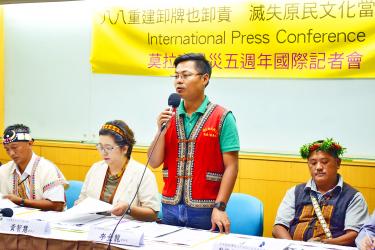As the government celebrates what it termed the “successful reconstruction” of areas devastated by Typhoon Morakot in 2009 and launched an exhibition highlighting reconstruction results, Morakot survivors yesterday accused the government of lying, saying that reconstruction is far from complete.
Morakot is considered the worst storm to hit the nation in 50 years; its massive mudslides caused almost 700 deaths, permanently changed the landscape and forced thousands of people to relocate.
Siaolin Village (小林) in what is now Jiasian Township (甲仙), Greater Kaohsiung, was completed buried by mudslides.
While the government celebrates what it called the completion of reconstruction five years after the disaster, many survivors disagreed.
“When reconstruction efforts started, the government promised that people would not be relocated too far from where they originally lived, but it is a lie,” Huang Chih-huei (黃智慧), director of Millet Foundation of Indigenous Peoples, told a news conference in Taipei. “The government relocated Rukai residents of Ali Village (阿里) to a different township, forcing them to spend NT$500 per day on gas to drive to and from work on fields in their original village,” Huang said. “It is impossible for these villagers to farm as they used to.”
“In addition, each household has been moved to a house of 16 ping [52.8m2], where it is very difficult for a big family to live,” he said.
Lee Jin-long (李金龍), director of the Industrial Development Association for the Rukai Village of Kocapognan, agreed.
“Ali Village residents were evicted and relocated without their consent, despite the original village not being too seriously damaged,” Lee said. “Besides, the government never asked for their opinions before building the new village, making it a place with no connection to Rukai culture and tradition.”
Lee said that although they have houses, their lives have not been rebuilt, since their farmlands are far away.
Isnankan Dahay, a resident of the Bunun Aboriginal Village of Nansalu (南沙魯) in Namasiya District (那瑪夏), Kaohsiung, said that at the time, the government promised to allocate farmland to each household, “but it never happened.”
With no source of income, many villagers — himself included — moved back to the original village where they have farms, he said.
“The government said that Nanshalu wouldn’t be suitable for residents for at least 50 years,” Dahay said. “Well, I’ve been back for five years now and everything is fine.”
Taiwan Association for Human Rights Secretary-General Tsai Chi-hsun (蔡季勳) said that many people — especially Aborigines forced to relocate — are still struggling to rebuild their lives, but the government is not helping, but rather is creating obstacles for them.
“This is why we’ve always stressed the importance of information transparency and public participation in decisions,” Tsai said. “Otherwise, anyone could be forced to relocate or give up their lifestyle due to government decisions.”
Source: Taipei Times - 2014/08/09





















